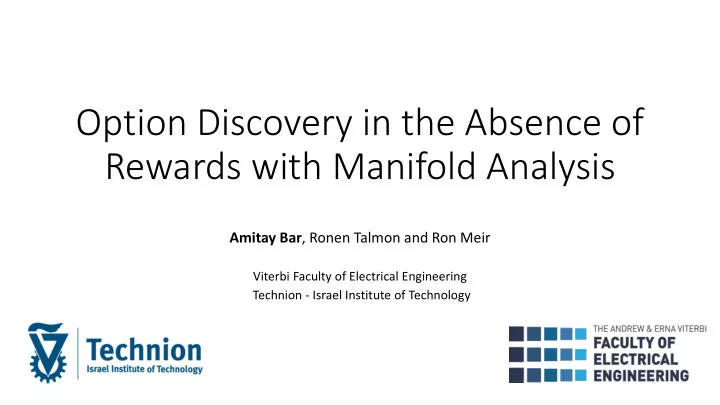

Option Discovery in the Absence of Rewards with Manifold Analysis Amitay Bar , Ronen Talmon and Ron Meir Viterbi Faculty of Electrical Engineering Technion - Israel Institute of Technology
Option Discovery ry • We address the problem of option discovery • Options (a.k.a. skills) are a predefined sequence of primitive actions [Sutton et al. ‘ 99] • Options were shown to improve both learning and exploration • Setting • Not associated with any specific task • Acquired without receiving any reward • Important and challenging problem in RL
Contribution • A new approach to option discovery with theoretical foundation • Based on manifold analysis • The analysis includes novel results in manifold learning • We propose an algorithm for option discovery • Outperforms competing options
Graph Based Approach • The finite domain is represented by a graph [Mahadevan ‘07] • Nodes - the states (𝕋 is the set of states) • Edges - according to the state’s connectivity • The graph is a discrete representation of a manifold State=Node M – Adjacency matrix D – Degree matrix 1 2 3 4 5 6 7 1 2 3 4 5 6 7 1 1 0 1 1 0 0 0 0 2 0 0 0 0 0 0 2 2 1 0 0 1 0 0 0 0 2 0 0 0 0 0 3 3 1 0 0 1 1 0 0 0 0 3 0 0 0 0 4 4 0 1 1 0 0 1 1 0 0 0 4 0 0 0 0 0 1 0 0 1 0 5 5 0 0 0 0 2 0 0 0 0 0 1 1 0 0 6 6 0 0 0 0 0 2 0 0 0 0 1 0 0 0 7 7 0 0 0 0 0 0 1
The Proposed Algorithm 1 2 𝑱 − 𝑵𝑬 −1 1. Compute the random walk matrix 𝑿 = ෨ 2. Apply EVD to 𝑿 and obtain its left and right eigenvectors 𝜚 𝑗 , 𝜚 𝑗 , and its eigenvalues 𝜕 𝑗 2 To be motivated 𝑢 𝜚 𝑗 𝑡 ෨ σ 𝑗≥2 𝜕 𝑗 𝑔 𝑢 : 𝕋 → ℝ , 𝑔 𝑢 𝑡 = 𝜚 𝑗 3. Construct later 𝑗 4. Find the local maxima of 𝑔 𝑢 𝑡 , denoted as 𝑡 𝑝 ⊂ 𝕋 𝑗 , build an option leading to it 5. For each local maximum, 𝑡 𝑝 𝑔 𝑢 allows the identification of goal states
Demonstrating the Score Function 2 𝑢 𝜚 𝑗 𝑡 ෨ 𝑔 𝑢 𝑡 = 𝜕 𝑗 𝜚 𝑗 • 4Rooms [Sutton et al. ‘99] 𝑗≥2 • The local maxima of 𝑔 𝑢 𝑡 are at states that are “far away” from all other states • Corner states and bottleneck states Low pass filter effect f 13 𝑡 f 4 𝑡
Experimental Results - Learning • Q learning [Watkins and Dayan, ‘ 92] • Eigenoptions [Machado et al. ‘ 17] Normalized visitation during learning * Further results in _paper Diffusion options (t=4) Eigenoptions Random walk
Experimental Results - Exploration • Exploration • Median number of steps between every two states [Machado et al. ‘ 17] [Machado et al. ’17] [Jinnai et al. ‘19]
Theoretical Analysis • We use manifold learning results and concepts • Diffusion distance [Coifman and Laffon ‘06] • New concept – considering the entire spectrum [Cheng and Mishne ‘18] • Comparison to existing work - eigenoptions [Machado et al. ‘17] and cover options [Jinnai et al. ‘19] • Use only the principal components instead of all/many • Consider only one eigenvector at a time, instead of incorporating them together
Diffusion Distance 𝑿 = 1 2 𝑱 − 𝑵𝑬 −1 𝑢 𝒙 𝑚 𝑢 − 𝒙 𝑡′ • Consider 𝑿 𝑢 = ⋯ ⋯ 𝑢 𝐸 𝑢 𝑡, 𝑡′ = 𝒙 𝑡 Euclidean distance Diffusion distance
Properties of of the Score Function Proposition 1 The function 𝑔 𝑢 : 𝕋 → ℝ can be expressed as 2 𝑡, 𝑡 ′ 𝑔 𝑢 𝑡 = 𝐸 𝑢 𝑡′∈𝕋 + 𝑑𝑝𝑜𝑡𝑢 2 𝑡, 𝑡 ′ • 𝐸 𝑢 𝑡′∈𝕋 is the average diffusion distance between state 𝑡 and all other states *See ICML paper for the proof
Properties of of the Score Function Proposition 1 The function 𝑔 𝑢 : 𝕋 → ℝ can be expressed as 2 𝑡, 𝑡 ′ 𝑔 𝑢 𝑡 = 𝐸 𝑢 𝑡′∈𝕋 + 𝑑𝑝𝑜𝑡𝑢 2 𝑡, 𝑡 ′ • Option discovery: max 𝑔 𝑢 𝑡 = max 𝐸 𝑢 𝑡′∈𝕋 Exploration benefits • Agent visits different regions • Avoiding the dithering effect of random walk *See ICML paper for the proof
Properties of of the Score Function Proposition 2 Relates 𝑔 𝑢 𝑡 to 𝝆 0 , the stationary distribution of the graph 2 𝑡 − 𝝆 0 1 2𝑢 𝑔 𝑢 𝑡 ≤ 𝜕 2 𝝆 0 𝑡 − 1 𝑔 𝑢 𝑡 = 𝒒 𝑢 • PageRank algorithm [Page et al. ’ 99, Kleinberg ‘ 99] Exploration benefits • Diffusion options lead to states for which 𝝆 0 𝑡 is small • Rarely visited by an uninformed random walk *See ICML paper for the proof
Ext xtensions and and Scaling Up Up • Extending diffusion options to stochastic domains • Stochastic domains → can lead to asymmetric matrices • We use polar decomposition on the graph Laplacian [Mhaskar ‘18] • Scaling up to large scale domains/function approximation case • [Wu et al. ‘19], [Jinnai et al. ‘20] • See ICML paper for further discussion and results
Summary ry • We introduced theoretically motivated options • Analysis based on concepts from manifold learning • Diffusion options encourage exploration • Lead to distant states in term of diffusion distance • Compensate for low stationary distribution values • Empirically demonstrated improved performance • Both learning and exploration
Thank you “ Option Discovery in the Absence of Rewards with Manifold Analysis ” , A. Bar, R. Talmon and R. Meir, ICML 2020
Recommend
More recommend